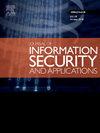IDHG-ECC-integrated Diffie Hellman Galois–elliptic-curve cryptography for enhancing EHR data security
IF 3.8
2区 计算机科学
Q2 COMPUTER SCIENCE, INFORMATION SYSTEMS
Journal of Information Security and Applications
Pub Date : 2025-03-11
DOI:10.1016/j.jisa.2025.104024
引用次数: 0
Abstract
Electronic Health Records (EHRs), which are used in modern healthcare systems, store private medical histories for a large number of people. A strong security architecture is required to guarantee patient privacy within EHR databases due to the importance of preserving this personal data. Improving data security and patient privacy during the transfer of sensitive information across healthcare providers for diagnostic purposes is the main emphasis of this work. To enhance the security of electronic health record data, this article proposes a new approach that combines a decentralized, secure blockchain paradigm with a lightweight cryptosystem. The proposed workflow starts with gathering electronic health record data from databases and initializing user transaction information to facilitate communication across various nodes. Public and private keys are produced via an elliptic scheme to enhance the security of health data. Then, medical data is encrypted and decrypted using Integrated Diffie-Hellman Galois-Elliptic-curve Cryptography (IDHG-ECC). The encrypted data is further strengthened by using a consensus process known as Affinity-Propagation encased Practical Byzantine Fault Tolerance (AP-PBFT). Extra security is provided by storing the encrypted data on the off-chain Inter Planetary File System (OIPFS) blockchain. In the evaluation, the proposed model attains efficient encryption and decryption times of 7.88 s and 1.80 s, respectively, with a quick uploading time of 0 .09s. It achieves high transaction throughput (78,288 TPS) with low latency (0.71 s), while read throughput is 137.54 MB/s with minimal latency (0.01 s). CPU utilization is moderate at 20.70%, and memory utilization is 54.00%, ensuring balanced resource management for optimal performance.
集成了idhg - ecc的Diffie Hellman伽罗瓦椭圆曲线加密技术,增强了电子病历数据的安全性
现代医疗保健系统中使用的电子健康记录(EHRs)存储了大量人的私人病史。由于保存这些个人数据的重要性,需要一个强大的安全架构来保证EHR数据库中的患者隐私。在医疗保健提供者之间为诊断目的传输敏感信息期间,改进数据安全性和患者隐私是这项工作的主要重点。为了增强电子健康记录数据的安全性,本文提出了一种将分散的、安全的区块链范式与轻量级密码系统相结合的新方法。所建议的工作流首先从数据库收集电子健康记录数据并初始化用户事务信息,以促进跨各个节点的通信。公钥和私钥通过椭圆方案生成,以增强健康数据的安全性。然后,使用集成的Diffie-Hellman伽罗瓦-椭圆曲线加密(IDHG-ECC)对医疗数据进行加密和解密。通过使用称为亲和传播封装的实用拜占庭容错(AP-PBFT)的共识过程,加密数据进一步得到加强。通过将加密数据存储在链外行星间文件系统(OIPFS)区块链上,可以提供额外的安全性。在评估中,该模型的有效加解密时间分别为7.88 s和1.80 s,快速上传时间为0.09 s。事务吞吐量高(78,288 TPS),时延低(0.71 s),读吞吐量高(137.54 MB/s),时延最小(0.01 s), CPU利用率适中(20.70%),内存利用率为54.00%,资源管理均衡,性能最优。
本文章由计算机程序翻译,如有差异,请以英文原文为准。
求助全文
约1分钟内获得全文
求助全文
来源期刊

Journal of Information Security and Applications
Computer Science-Computer Networks and Communications
CiteScore
10.90
自引率
5.40%
发文量
206
审稿时长
56 days
期刊介绍:
Journal of Information Security and Applications (JISA) focuses on the original research and practice-driven applications with relevance to information security and applications. JISA provides a common linkage between a vibrant scientific and research community and industry professionals by offering a clear view on modern problems and challenges in information security, as well as identifying promising scientific and "best-practice" solutions. JISA issues offer a balance between original research work and innovative industrial approaches by internationally renowned information security experts and researchers.
 求助内容:
求助内容: 应助结果提醒方式:
应助结果提醒方式:


